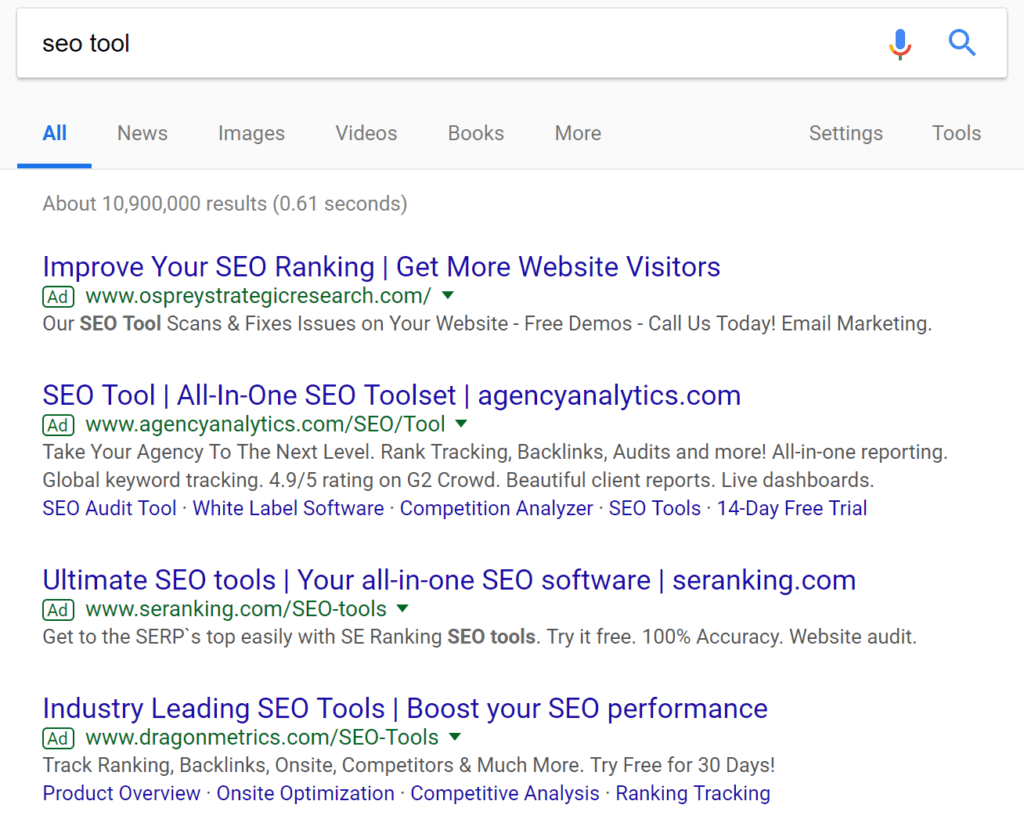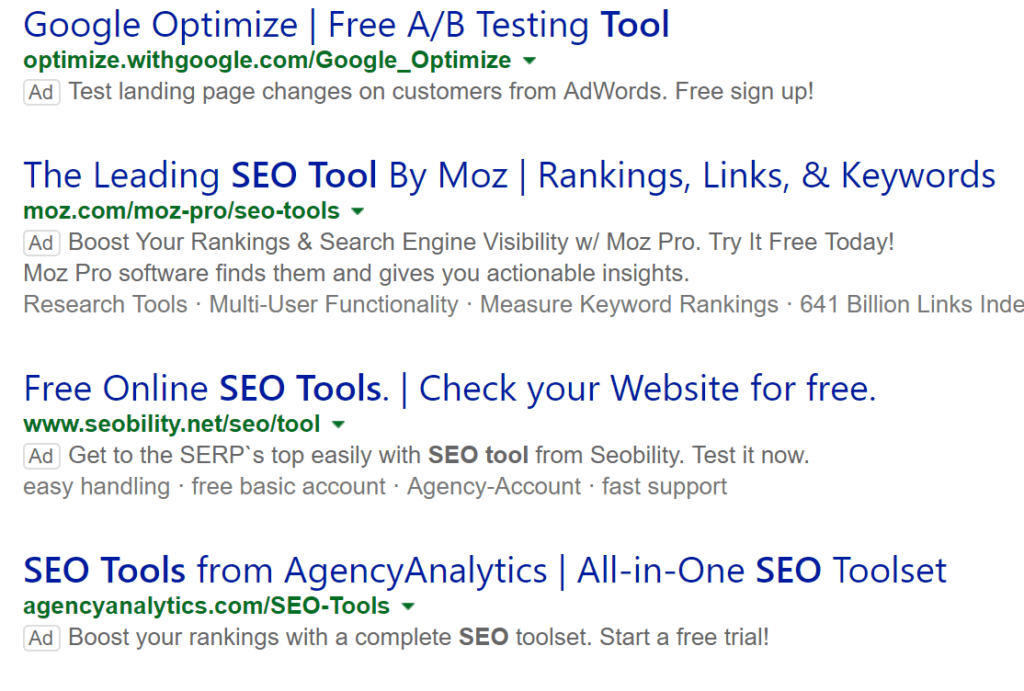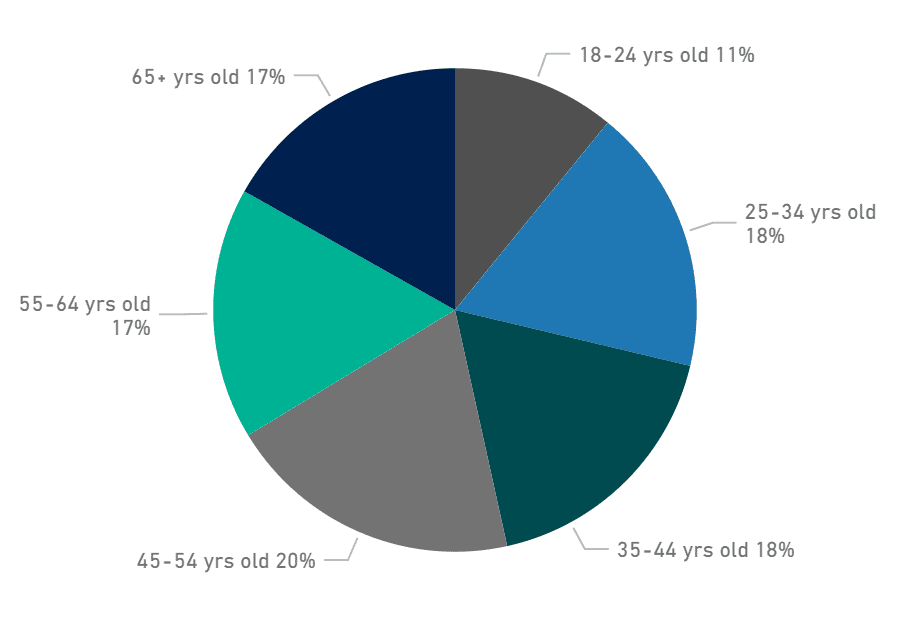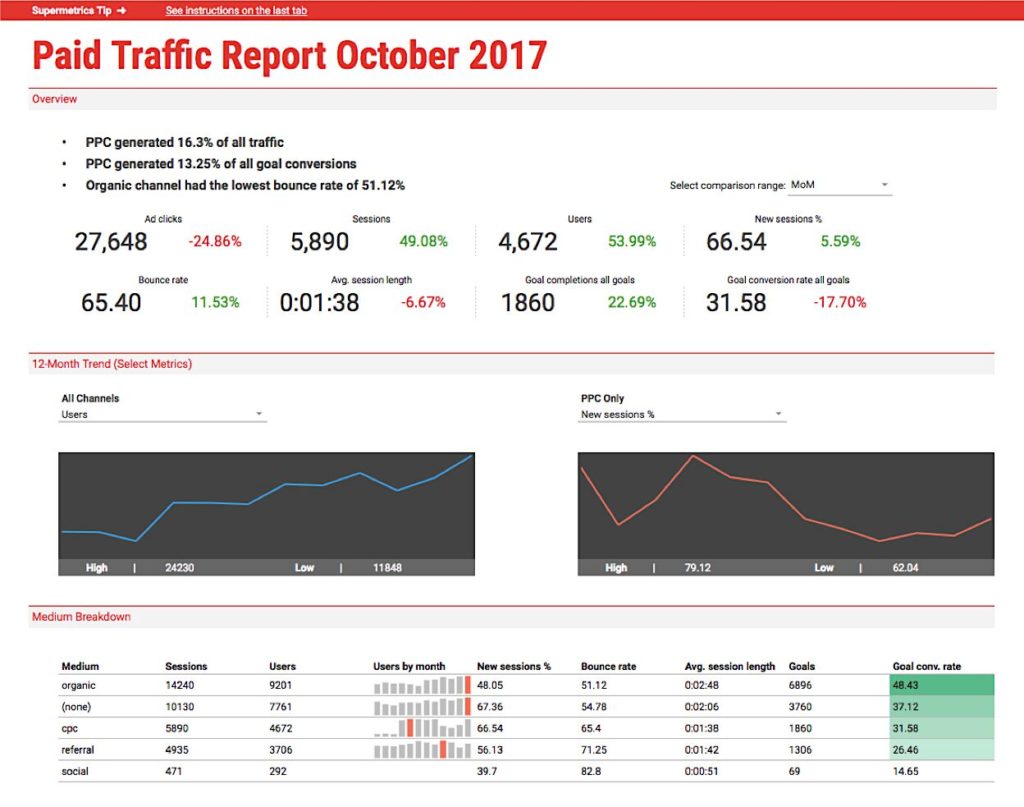Google dominates when it comes to search engine traffic, making it easy to find people interested in your products and services.
While that’s a huge benefit, it also comes with a massive downside:
Competition.
Google is packed to the brim with advertisers bidding on the keywords you want and need.
Meanwhile, people brush off Bing like it’s a joke.
And that’s good for business:
Less competition.
Bing might have less overall usage and therefore less traffic, but what if you could capture that traffic without competing against dozens of advertisers?
Let’s find out.
Google or Bing? How They Work and Their Key Differences
While both Bing and Google are popular search engines, they work in different ways and encompass a variety of different tools.
In this segment, we will show you how these two advertising giants work and what networks they cover.
Let’s kick it off with Google.
-
Google Ads: How Do They Work?
On Google, you have two distinct options when it comes to creating new ads:
- The Search Network: The search network involves all types of Google search engines. For instance, if a user heads to Google search, you can show an ad for that. If a user searches on Google Maps, that also falls under the search network. Google Shopping for e-commerce is also a search network entity.
- The Display Network: The display network is visual-focused, allowing advertisers to display visual or video content on YouTube, Gmail, Blogger, and Google Partner Sites.
With Google Ads, you can run ads across these two networks for maximum reach and effectiveness. Combining tactics is the gold standard on these networks.
-
Bing Ads: How Do They Work?
Bing Ads work slightly differently than Google Ads.
Bing is currently owned by Microsoft, who also owns Yahoo and AOL.
Advertising on Bing means that your ads will display on all three search engines: Bing, Yahoo and AOL.
On top of that, Bing Partner Sites allow you to display both text and visual-based ads.
-
Google Ads: How Do They Look?
When searching for products and services on the Google search network, you will see results like this:
-
Bing Ads: How Do They Look?
Similarly, on Bing, results look almost identical at first glance:
Some minor key differences you might notice are within the display URLs on Bing and Google.
- With Google, display paths contain “WWW” while Bing does not.
- The “Ad” button indicating that the result is an ad is highlighted on Google, but not on Bing, possibly resulting in better ad CTR on Bing.
In terms of the networks, Bing differs from Google in that they cannot offer ads on widely used platforms like Maps and YouTube as Google owns them. This limits Bing’s reach and diversity of offerings.
While both have the ability to advertise on partner websites, it’s a big loss for those looking to advertise on multiple unique channels.
Let’s dive a bit deeper on both Bing and Google to look at the pros and cons as well as the demographics you can expect on each search network.
All About Bing: Who Uses it? Pros and Cons of Bing
When you ask a given PPC marketer what platform they prefer, most will say Google. Why?
Simply because it’s more popular. They are more familiar with it. There are exponentially more articles and guides online helping marketers succeed on Google Ads compared to Bing Ads.
With Bing being founded in 2009 and Google starting in 1997, it’s no wonder that Google dominates the market share. They’ve been around longer and have built a seemingly unshakeable foundation.
Google has impressive features that you hear about in the mainstream news, but that doesn’t mean Bing is worthless.
In fact, it’s far from that.
According to the latest data, Bing has a 33% market share in the United States and a large market share in countries worldwide.
Currently, six billion unique monthly searches are happening on Bing’s search network.
The monthly active user base of Bing is currently 145 million, providing ample opportunity for search advertisers to reach their desired target market.
On top of that, here is the real kicker that sets Bing apart from Google Ads:
Bing allows you to reach 66 million users across all industries and verticals that aren’t reached on Google.
This is a huge opportunity for advertisers in competitive fields.
Millions of people advertise on Google, making it overcrowded and saturated. Want to rank higher on Google Ads? You need more money. Higher bids. Better ads.
But on Bing, you have dramatically fewer competitors. Overall, this brings down the cost of your clicks dramatically.
In fact, the average cost per click on Bing is much cheaper than Google:
Cheaper clicks mean more money to spend on bringing new visitors in the door and ultimately, a better return on your investment (ROI).
Based on averages, you could convert more than two users for the price of one on Google.
So, who uses Bing in 2018?
Can you really find the right audience on Bing compared to Google’s reach?
- According to Bing, half of the users on their audience network are married or living with a domestic partner.
Depending on what type of product you sell, Bing’s demographics can either work for or against you.
- According to Bing, about 40% of the network is between 35-54 years old.
Meanwhile, on Google, you can find a wider variety of younger searchers.
Bing packs some seriously wealthy users:
- According to Bing, over one-third of Bing searchers have a household income of over $100,000.
But demographics on Bing tend to be older and limited to mostly the United States.
In terms of cons, Bing simply produces less search volume in comparison to Google.
If your goal is to bring in high-volume traffic and tons of brand awareness, Bing might not be your go-to.
If international advertising is significant for you, Bing won’t perform as well.
Let’s recap the pros and cons of Bing:
Pros:
- Large market share in the United States 👌
- 6 billion unique monthly searches 👌
- 140 million monthly users searching 👌
- Reach 66 million searchers that aren’t using Google 👌
- Cheaper cost per click than Google Ads 👌
Cons:
- Older demographic is predominant 👎
- Lower search volume than Google 👎
- Smaller market share than Google in and outside of the United States 👎
- Harder to reach international audiences 👎
Is Google Really the Best? Pros and Cons of Google
It’s no secret that Google dominates the search engine market share worldwide.
“Just Google it” is a phrase you’ve probably heard more times than you can count in a 24-hour window.
Just Bing it? Never heard it.
The Google brand is synonymous for every single search engine ever, despite many others existing.
But just because something is widely popular doesn’t mean it’s the most optimal, effective, and ROI producing.
Let’s take a look at who uses Google in terms of demographics.
- According to Aborg, Google accounts for 80% of searches conducted in Canada.
- 50% of people using Google are in the United States, yet Google still holds the largest market share in almost all countries across the globe.
Generally speaking, Google has a younger, more tech-savvy demographic that is more likely to be using multiple social and search channels.
The sheer amount of people using Google is a pro: You have more chances and possibilities to reach the right users that want your products and services. You can bet that your target market is using Google.
Why? Because
Google handles an insane amount of searches: 63,000 per second. That’s 3.8 million per minute and a total of nearly two trillion per year.
With proven networks like the display and search network as well as video on YouTube, you have endless ways to reach users beyond just the search network itself.
Want to target YouTube users who watch hours of video per day? Check. Want to reach users across the web beyond just Google searches? Target partner sites.
Your targeting options are almost limitless on Google.
With such great targeting options, reaching your demographics is easy. And when reaching the right people is easy, so is making a profit.
Latest data shows that the average advertiser on Google produces a profit of $2 for every $1 spent
Anyone can expect to double their investment on average.
With such great features, demographics, and statistical data to back up the prowess of Google, it’s not free from its cons.
Everybody wants a piece of the Google pie. The promise of big ROI and reaching anyone, anywhere, at any time.
This means competition. More advertisers are competing for the same traffic as you.
In terms of cons, cost per clicks is much higher on Google than Bing.
You are simply going to have to bid a bit more than you would on Bing to rank in the top ad positions.
Let’s recap some of the pros and cons of Google:
Pros:
- Huge market share worldwide 👌
- Trillions of searches yearly 👌
- Great ROI: $2 for every $1 spent 👌
- Diverse demographics 👌
- Great targeting and advertising networks: Search, Display, YouTube 👌
Cons:
- Competitive: more advertisers choose Google, making it increasingly harder to drive traffic 👎
- It’s way more expensive than Bing 👎
Before you make up your mind based on the pros and cons of Bing and Google, it’s important to take into account one major thing:
User experience.
Which platform is easiest to use, navigate, and find data on your reports?
This critical factor can impact your willingness to spend time using the platform and how you interpret and apply data to generate better results.
Let’s find out.
Reporting: Which Has Easier to Use Reporting and Account Maintenance?
If you have ever used either platform or similar PPC platforms like Facebook and Twitter, you likely know that account maintenance and quality reporting are tedious and hard to come by.
You could spend hours on each platform collecting data and analyzing reports with little to show for it.
Reporting can truly make or break your experience.
If you hate and dread reporting, you are far less likely to do it, leading to performance decline and potential loss of profit.
PPC should be a fun, exciting experience that you enjoy.
Here’s an overview of reporting on each platform and what you can expect from each.
Google Ads Reporting and Account Maintenance
Overall, Google provides excellent dashboards for reporting and some amazing options to set and forget your campaigns while still generating significant returns.
You can use search terms reports to find new campaign ideas or create negative keyword lists to refine your campaigns.
Comparing mobile and desktop performance has never been easier.
But the icing on the cake for Google Ads over Bing is the direct and easy integration with Google Analytics.
With the click of a button, you can connect to Analytics and use that as your primary report builder, allowing you to compare metrics from PPC to Organic to Social and more.
When it comes to reporting, Google wins.
Bing Ads Reporting and Account Maintenance
Like Google, Bing has solid dashboards that have been updated and continually receive updates to include new metrics:
For instance, you can custom create reporting modules on just about anything:
Want to run a report on active keywords and ad groups compared to old campaign performance? You can do it.
Want to run a search term or a negative keyword list like Google? Not a problem.
While Bing obviously lacks direct integration with Google Analytics, it still has some great and alike features to Google that will drive results.
A few major flaws in both platforms’ reporting features is the inability to collaborate effectively or create detailed custom reports comparing the performance of both networks simultaneously as well as potential click fraud.
It’s tedious enough as is to analyze data sets from a single platform, let alone both.
To work around this, you can start by utilizing Google’s latest addition to Google Ads: Google Sheets integration.
With the integration, you can directly create new reports that sync into your sheet and refresh them at any moment.
That means you only have to create custom reports once. You don’t have to consistently add filters every time you open Google Ads.
Want to correlate this data back with Bing Ad performance?
Simply export your Bing Ads data and upload it into your Google Sheet, aligning the dates to compare results across the week, month, or quarter.
While this isn’t ideal, it’s much faster than exporting both data sets every week as Google data automatically gets populated into your spreadsheet.
Another alternative is to use metric platforms that simplify the process for you. For instance, SuperMetrics integrates directly with Google Sheets, allowing you to compare both Bing and Google ad data without ever exporting anything on your own.
Just select the channel and platform, and you can compare both networks using tables and graphs in seconds while the platform pulls data from each one automatically.
When it comes to click-fraud, neither platforms offer anything useful.
What’s click-fraud? It’s when competitors start to spam-click on your ads and waste tons of your money without ever converting or when bots generate your traffic.
Either way, you’re losing hard earned money every single time.
Latest data shows that 40% of internet traffic is bots, too. Often, competitors can hire “click farms” that will send large-scale bot traffic to sabotage your campaigns and cost you a fortune with no results.
On Bing and Google, you have no way of knowing. Consider using a click-fraud software no matter which direction you choose to go.
The Verdict: Google or Bing? (Or Both?)
Chances are, you are already using Google, and that’s great.
If your demographics line up for Bing, it’s a no-brainer.
Bing has cheaper costs, amazing features, and a growing user base.
But before you decide on either one, you should analyze your budget to see if you can afford to use both without spreading your efforts too thin.
If you are only spending $50 per day on Google Ads and can’t spend much more, I’d recommend sticking to just Google.
Why?
Depending on your average cost per clicks, that might only result in a few clicks per day, which is already slow enough.
Halving your budget and reducing it to $25 on each platform is a recipe for slow results.
If you are running ads on Google, take a look at your average CPC for your live campaigns and relate that to your current budget/daily max spend:
Take the average cost per click for a given campaign and divide it into your daily maximum budget to see how many clicks you generate in a single day.
If the number is low, heading to Bing will likely spread your efforts too thin and reduce the rate at which leads come in the door.
If you don’t currently advertise on Google, analyze the average CPC for your expected keywords using a tool like SEMRush. Search for potential keyword phrases and do the same math with the average CPC and your expected daily max budget:
Can you realistically advertise on both platforms with your current budget? If not, test the waters with one network first.
Can you increase your budget allocated to PPC advertising? If so, try both!
The thing with PPC is:
You never know what works until you try it.
Every network, industry, and tactic will work differently based on what company implements it.
One great feature with Bing is being able to import existing Google campaigns directly into their platform, allowing you to save tons of time and work.
If you have some extra budget to spare, give Bing a shot too.
If advertising budgets are tight, pick a platform and run with it. Google is likely your best bet if you are sticking to a single platform.
Bottom line: Google should be the go-to platform if you can only pick one. It packs more diverse ad and network offerings (maps, shopping, YouTube) and a larger user base. But if you can afford to increase your budget, close loopholes, and reach unreached users with Bing, then use both to dominate with a broader online presence.
Conclusion
Google and Bing both pack some powerful, impressive features.
Each network gives you the chance to reach your target market.
While Google is more widely used worldwide and contains higher search volumes, it also is more expensive than Bing, and the competition is much higher.
Bing is cheaper per click, and you don’t have to worry about overcrowded SERPs.
With that said, which one do you choose?
If your marketing and PPC budget is flexible and high, you should definitely give both a shot.
If budgets are low, don’t spread yourself too thin.
Analyze the demographics of each platform and make a decision based on where your target market will most likely be.
Google and Bing can seem like a competition, but if you can dominate multiple platforms, you shouldn’t hesitate to do so.
















Hi Brad,
Do you have Google svs Bing CPCs by popular industry verticals?
Hi Brad, Thanks for the great post. We recently moved most of our search dollars to Bing and your comments have reinforced our decision. Regards, Andrew
“Bing is currently owned by Microsoft, who also owns Yahoo and AOL.”
I would say that this is a misleading statement. Microsoft only owns Bing and has partnerships with Yahoo and AOL. This is manifested in Yahoo!’s search engine, Gemini, where Bing traffic is sometimes served.
I think Google is lot more bigger than Bing
and when it comes to ads Google has a big scope .
Awesome comparison between Google and Bing search advertising. Bing gives a much less cost per click for the same keyword when compared with Google. I’m thinking of using bing to promote my blog post.